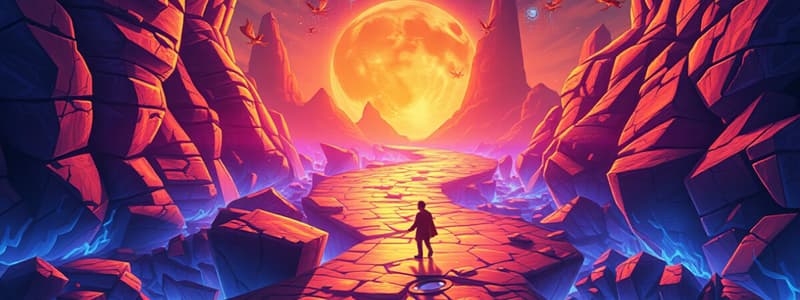Podcast
Questions and Answers
What is the minimum throughput required for real-time processing?
What is the minimum throughput required for real-time processing?
- 18 frames per second (FPS) (correct)
- 24 frames per second (FPS)
- 60 frames per second (FPS)
- 30 frames per second (FPS)
At a target of 24 FPS, how much computation time per pixel is required for a resolution of 1024 × 768?
At a target of 24 FPS, how much computation time per pixel is required for a resolution of 1024 × 768?
- 135 ns
- 77000 ns
- 40 ns
- 53 ns (correct)
Which of the following accurately represents how color is stored in machine code?
Which of the following accurately represents how color is stored in machine code?
- As a 16-bit grayscale value
- As a mem block of 24-bits (correct)
- As an array of 32-bits
- As a vector of RGB values
What does interpolation primarily involve in the context of visualization?
What does interpolation primarily involve in the context of visualization?
For a GPU with 384 cores, what is the computation time per pixel for a resolution of 1920 × 1280?
For a GPU with 384 cores, what is the computation time per pixel for a resolution of 1920 × 1280?
Which of the following display technologies was introduced in 1995?
Which of the following display technologies was introduced in 1995?
What is one of the key components mentioned in the graphics outline that is related to performance limitations?
What is one of the key components mentioned in the graphics outline that is related to performance limitations?
Which printing method is associated with modern raster graphics?
Which printing method is associated with modern raster graphics?
In the context of graphics displays, which device is a variant of a neon lamp?
In the context of graphics displays, which device is a variant of a neon lamp?
What kind of printing technique does thermal printing (thermochromic) belong to?
What kind of printing technique does thermal printing (thermochromic) belong to?
Which of the following is NOT mentioned as a form of raster display technology?
Which of the following is NOT mentioned as a form of raster display technology?
Which application listed in the content is primarily associated with the format of Flatland?
Which application listed in the content is primarily associated with the format of Flatland?
What is a common characteristic of the technology known as E-Ink?
What is a common characteristic of the technology known as E-Ink?
What is the primary function of the Vertex Shader in the graphics pipeline?
What is the primary function of the Vertex Shader in the graphics pipeline?
In the context of the graphics pipeline, what does the Triangle Assembly stage accomplish?
In the context of the graphics pipeline, what does the Triangle Assembly stage accomplish?
Which component of the graphics pipeline is responsible for determining the color of pixels?
Which component of the graphics pipeline is responsible for determining the color of pixels?
What does the Rasterisation stage of the graphics pipeline do?
What does the Rasterisation stage of the graphics pipeline do?
What type of geometrical shape is NOT part of the defined types in the content?
What type of geometrical shape is NOT part of the defined types in the content?
Which data does the Framebuffer hold?
Which data does the Framebuffer hold?
Which aspect of the Fragment Shader involves input from the previous stage?
Which aspect of the Fragment Shader involves input from the previous stage?
What could the uniform state in the vertex shader represent?
What could the uniform state in the vertex shader represent?
Which of the following best describes the role of the Element Array?
Which of the following best describes the role of the Element Array?
What is a heat gradient used for in graphical data visualization?
What is a heat gradient used for in graphical data visualization?
Flashcards are hidden until you start studying
Study Notes
History of Graphics
- Early applications of graphics include sketches on clay tablets and woodblock printing.
- The evolution of display technology spans from monochrome cathode ray tubes to modern displays like LCD, LED, and OLED.
- Key historical pieces: Sketchpad (1960), Flatland (1999), Plushie (2007), and CityEngine (2012).
Constraints of Real-time Graphics
- Real-time processing requires minimum throughput of 18 frames per second (FPS) and a refresh rate of at least 24 Hz.
- Computation time depends significantly on resolution; higher resolutions result in shorter per pixel computation times (e.g., 320×240 resolution takes approximately 543 nanoseconds).
Graphics Terminology
- Representation: Conceptual data structures in machine code, such as RGB for color, polygons for geometry, and 2D images for textures.
- Transformation: Altering viewpoint within the graphics environment.
- Interpolation: Estimating the values between two states, crucial for visual continuity.
The Graphics Pipeline
- The process includes several stages: Data Input → Vertex Shader → Triangle Assembly → Rasterisation → Fragment Shader → Framebuffer.
- Each stage modifies the data:
- The Vertex Shader processes per-vertex data, passing on the position.
- Triangle Assembly organizes vertex data into triangles.
- Rasterisation determines how elements correspond to screen fragments.
Types of Geometry
- Defines three major types: Point, Straight Line, and Planar Polygon.
- Includes specific shapes like Triangles and Quads for more complex representations.
Problem-Solving in Graphics
- Task example: Drawing a straight line with attributes for position in 2D and a temperature value, utilizing a heat map for color representation.
Modern Developments
- Transition from traditional printing methods (e.g., rotary presses, screen printing) to digital techniques (e.g., laser printing).
- Adoption of advanced display technologies improves how images and graphics are rendered in real-time environments.
Studying That Suits You
Use AI to generate personalized quizzes and flashcards to suit your learning preferences.




